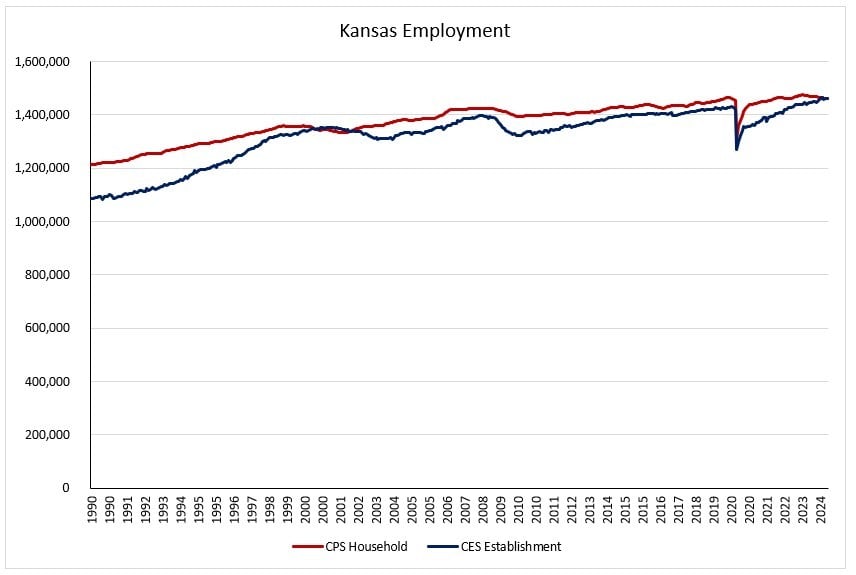Kansas Governor Laura Kelly and Lt. Governor/Secretary of Commerce Doug Toland have routinely touted tens of thousands of “jobs created or saved” — without substantiation — since the start of the Kelly administration in 2019. However, the actual numbers paint a far different picture.
At a recent “Governor’s Conference on the Future of Agriculture,” Toland stated that “68,000 new jobs have been created since we started in 2019.” But the facts are radically different. Numbers from the federal Bureau of Labor Statistics show that employment in Kansas had been growing fairly steadily since 1990 but has seen much flatter growth since 2015.
BLS conducts two employment surveys. Data in the Current Employment Statistics (CES) program, called the establishment report, is provided by employers based on their geographic location and tracks payroll jobs in nonfarm establishments, excluding agricultural workers, the self-employed, and private household employees. The Current Population Survey (CPS), the household survey, includes jobs for the self-employed and those in private households based on where they live.
The Kansas Department of Labor typically reports CES data, which means people living in Pittsburg but working across the state line in Joplin, Missouri, are not counted as working, but Missouri residents working in Overland Park are included.
 Neither BLS report substantiates Toland’s claim of 68,000 new jobs. The establishment report shows employment increased by about 42,000 between January 2019 and July 2024, but the household survey shows a gain of just 12,000. The more comprehensive household survey, counting farm workers and the self-employed, shows Kansas lost 13,000 jobs between July 2023 and July 2024.
Neither BLS report substantiates Toland’s claim of 68,000 new jobs. The establishment report shows employment increased by about 42,000 between January 2019 and July 2024, but the household survey shows a gain of just 12,000. The more comprehensive household survey, counting farm workers and the self-employed, shows Kansas lost 13,000 jobs between July 2023 and July 2024.
In fact, July 2024 employment, according to the household survey, shows fewer people working now than before Governor Kelly closed the state in reaction to COVID.
In a piece for the Kansas Policy Institute — which owns The Sentinel — KPI Economist Vance Ginn noted the pattern.

“For example, nonfarm employment grew from 1.08 million in 1990 to 1.12 million by the mid-1990s, reflecting the state’s overall economic growth,” he wrote. “However, the early 2000s saw a dip in employment due to the dot-com bubble burst, with a more substantial decline during the Great Recession. Post-recession recovery was slow but steady, with household and nonfarm employment regaining much of their lost ground by 2015.
“By 2019, Kansas had reached new employment highs. However, the COVID-19 pandemic disrupted these gains, causing sharp declines in employment across the state. Although there has been a recovery since then, the 2024 employment trends show a divergence that mirrors broader national patterns.”
As the chart below shows, there was a significant dip in employment during the COVID-19 pandemic, and most — if not all — of the jobs Kelly and Toland are claiming to have “created or saved” are simply bouncing back and returning to the status quo.

Ginn agreed.
“It’s basically flat since then,” he said. “There hasn’t really been any new job creation, and employment in particular, and even the non-farm is … positive a little bit, but not by a lot, These numbers are way off compared to what they’re trying to sell them as.”
However, since January 2020, through July 2024 there is actually a net loss of 3,010 jobs and since July of 2023 the state has lost 13,146 jobs, according to the CPS figures.
“It’s kind of like how [President Joe] Biden says he created 15 million jobs, but of course, 10 million of those were all from recovered jobs, not new jobs,” Ginn said. I think that’s the big difference here: they’re ‘recovered jobs,’ if they were lost during the pandemic, and then they’re just getting back now to different people. They’re not going to be the same people or the same jobs, but they’re just recovering the jobs lost.”
The Kelly/Toland administration’s claim may be based on the theoretical jobs created by the taxpayer subsidies that the administration cannot or will not substantiate. Still, the data shows that subsidies are not solving the state’s decades-long economic stagnation.



